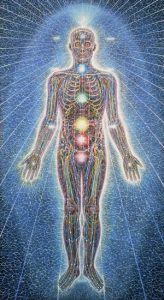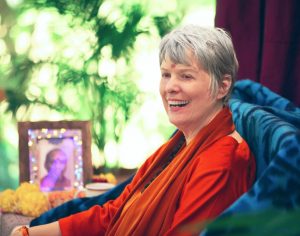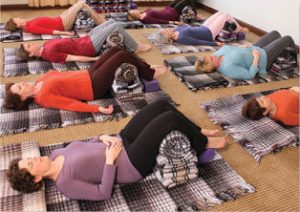When you lie in yoga’s Shavasana, your whole body gets to deeply relax. More than mere relaxation (as good as that is), each time you do Shavasana you are developing your ability to release multiple layers of tension from both your body and your mind. Your body and mind both enjoy a profound sense of ease, with an inner spaciousness that you are meant to be living in all the time.
Unfortunately, when you get up and get moving again, you are still able to recreate the too-familiar tensions again. You go back to life, and begin to tighten up. We call this “relapse;” you are going back to how you felt before. Instead of living in the inner spaciousness of your own Beingness, you end up living in relapse.
How can you carry the inner openness of yoga into daily life? To answer this, you must understand the mystery of the human body.
There are many ways to work with your body in the yoga world, as well as in athletics and different forms of exercise. Svaroopa® yoga works with your body in a very different way because we understand your body to be something different. Instead of treating your body:
- like a performance machine — that can be fine-tuned and improved,
- like an artist’s canvas — that can be made more beautiful and more able to express the art and grace of the human form,
- like a yardstick — that can be used to measure your beauty, your attractiveness to someone else, or your individual personal value or worth,
- like a hunk of meat — that has to be dragged around with you and is always threatening to pull you down into the mundane world, or threatening to look bad or smell bad or create some problem for you…
 Svaroopa® yoga sees your body as Divine, an individualized expression of the One in a physical form. Consciousness alone has become everything that exists, including your body and mind. The One Reality which has always existed, yoga calls Shiva. Shiva decided to move, to dance, to play at being many — becoming you and I, and everything that exists. That movement is called Shakti. Shakti is moving Shiva, and is the energy that becomes the atoms. Atoms manifest into everything that exists, including your own body. Your body is a physical expression of the One.
Svaroopa® yoga sees your body as Divine, an individualized expression of the One in a physical form. Consciousness alone has become everything that exists, including your body and mind. The One Reality which has always existed, yoga calls Shiva. Shiva decided to move, to dance, to play at being many — becoming you and I, and everything that exists. That movement is called Shakti. Shakti is moving Shiva, and is the energy that becomes the atoms. Atoms manifest into everything that exists, including your own body. Your body is a physical expression of the One.
This is the mystery of the human body. You can delve into your body and open up what is contained within it, like you open up a Christmas present. In Svaroopa® yoga, the body itself is your field of inquiry. More than merely discovering muscles and bones, this inner inquiry opens to progressively deeper levels of the inner dimensions of your own being.
Your mind is made of the same Shakti that becomes the atoms, but your mind exists at a less dense level of contraction. Your body and your mind are not two separate things that are in relationship with one another. Your body and your mind are both outward expressions of only one thing — you. They are two different levels of the blossoming of consciousness into a unique and individual manifestation — you. Consciousness becomes you by shaping your mind into its tangible form on the subtle level, and then further condenses into the physical level as your body. Your body is the outward expression of your mind. Anything you do with one affects the other.
This means that you can think yourself into relapse. Whether you do 20 minutes of yoga or devote a full weekend or week to it, you can tighten right back up with just a few minutes of worry. Your body responds to every thought as though you were living through the experience. If you think about walking down a dark alley at night, your body goes through the physical experience as though you were really there — your tailbone tightens, your breath shortens and the adrenaline pumps into your cells. If you use your mind to run reruns of the worst experiences of your life, your body relives it every time you think it. You can even have physical experiences of things that have never happened if you merely project that your future will be full of your worst fears.
 While we work with your body, the purpose is to change the way your mind works. The ancient teachings of yoga clearly state that the purpose is to work on your mind. We work with your body because it is so easy to change your body. Most of your aches and pains go away within four or five Svaroopa® yoga poses. At the most, it takes a few classes and Embodyment® sessions. The good news is that there is no reason for you to live in chronic pain and tension. Feeling better is just a few minutes away. And feeling better has an effect on your mind.
While we work with your body, the purpose is to change the way your mind works. The ancient teachings of yoga clearly state that the purpose is to work on your mind. We work with your body because it is so easy to change your body. Most of your aches and pains go away within four or five Svaroopa® yoga poses. At the most, it takes a few classes and Embodyment® sessions. The good news is that there is no reason for you to live in chronic pain and tension. Feeling better is just a few minutes away. And feeling better has an effect on your mind.
But if you don’t work with your mind directly, then you reinstate the prior problems with every thought. The only way to stay out of relapse is to begin the process of quieting your mind. Once you experience a quiet mind, you will always want to have a quiet mind. This inner quietude frees you from the extraneous internal chatter and makes you more effective at everything you do. At the same time, your quiet mind becomes an avenue that you can use to look more deeply inward — to find your Self, which is consciousness-itself.


